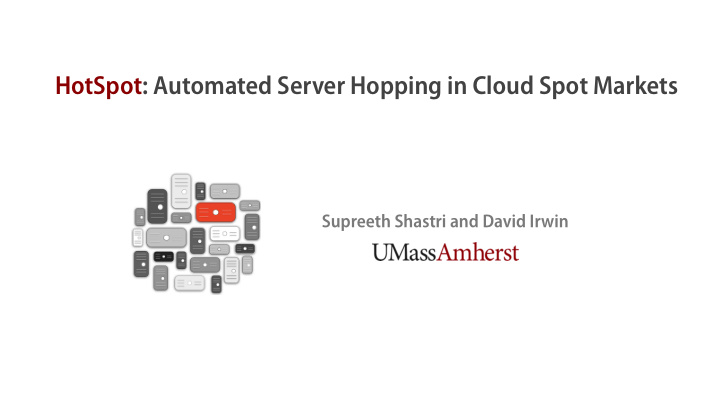



HotSpot: Automated Server Hopping in Cloud Spot Markets Supreeth Shastri and David Irwin
Transient Servers are Ubiquitous in the Cloud Servers that may terminate anytime after an advance warning period Internal Use : Resource Spot Instances : variable- Preemptible VM : short-lived harvesting in datacenters priced transient VMs offered VMs offered at fixed but via second price auction [SoCC 2016. OSDI 2016, ATC 2017] discounted prices Yank, NSDI 2013
EC2 Spot Markets in a Nutshell 7600+ spot markets worldwide 3 1 2 EC2 evaluates supply- EC2 allocates if bid The users bid for demand dynamic to price ≥ spot price; VMs in a second price spot servers Revokes when not. price auction The defining characteristics of spot VMs are low average price and unexpected revocations Applications and frameworks do not perform well when the underlying servers are frequently revoked
Prior work treats revocations as failures , … but and employs fault-tolerance to reduce its impact insurance-like approaches ignore 2015 2016 2017 Price Risk SpotOn [ SoCC ] TR-Spark [ SoCC ] Proteus [ EuroSys ] i.e the risk that a VM’s price SpotCheck [ EuroSys ] Flint [ EuroSys ] Pado [ EuroSys ] will increase relative to others Cumulon [ VLDB ] BOSS [ Infocom ] Exosphere [ Sigmetrics ] Fault-tolerance ≅ insurance users pay upfront premiums (i.e., fault-tolerance overhead) and expect a payout later (i.e., ability to limit the loss of work)
Does mitigating the price How to enable flexible cloud risk affect performance applications to mitigate the and revocation risk? price risk transparently? HotSpot: Automated Server Hopping
Automated Server Hopping ❝ Change, before you have to ❞ A resource container that automatically hops Results from the EC2 spot market spot VMs as market conditions change US-East-1 markets (3/1/2017 - 5/1/2017) Ideal savings from hopping vs. staying for a long-running job (30 days) Quote from Jack Welch, former CEO of General Electric
Effect on Revocation Risk and Performance Insights from spot market analysis Highly discounted servers 2 1 Cost efficiency is uncorrelated with VM capacity (and thus performance) tend to have lower revocation risk Server hopping lowers revocations without necessarily degrading performance
Design of Server Hopping Logic ( ) Trigger a check whenever Run on a VM that has the best Migration policy ๏ VM utilization changes cost-efficiency in $/utilized-resource without hindering the performance ๏ spot market prices change Policy invariant Cost-benefit analysis Migrate to the spot vm that gives the highest cost-benefit gain Migration cost Expected benefit ๏ Gain in cost-efficiency for the ๏ Double-paying for VMs + > duration of expected stay min. VM holding time ๏ ⨍ (market characteristics) ๏ ⨍ (application footprint)
HotSpot: Design and Implementation Fully functional prototype available at: https://sustainablecomputinglab.github.io/hotspot/
Evaluation Compare cost, performance, revocations of running a flexible batch application on Spot VM Spot VM Spot VM vs. vs. with fault-tolerance with server hopping with no protection (SpotOn [ SoCC 2015 ]) (HotSpot) (SpotFleet) 1. How do changes in job and market characteristics affect each approach? Run the prototypes on EC2 (but control job and market conditions using emulators) 2. How do different approaches perform on the real market for real jobs? Simulate running Google cluster trace jobs on Amazon spot price traces (03/2017 to 05/2017)
Google Cluster Traces on EC2 Spot Markets Even in the current EC2 spot markets (with low revocation rates), optimizing for price-risk results in 30-50% additional savings without degrading performance
Conclusion Transient server markets are an emerging area and offer many opportunities for cost savings Price Risk HotSpot Evaluations 30-50% Cost reduction vs. other techniques Price risk is significant in Proposed the technique of current spot markets automated server hopping ๏ Lower Overhead ๏ Lower Revocations Mitigating price risk also Designed and implemented ๏ More Deterministic reduces revocations HotSpot for EC2 spot markets
Backup Slides
Price Risk >> Revocation Risk Data from all 402 spot VMs in US-East-1 over 3/1/2017 to 5/1/2017 Time-to-Change (TTC) for the Mean Time-to-Revocation (TTR) when cheapest VM is 1.1 hours bidding 1x is ~25 days and 10x is ~47 days
Migration Latencies in EC2 Platform’s API operations
Effect of Changes in Market Volatility As markets become more volatile, HotSpot’s savings will improve relative to SpotFleet and SpotOn
Effect of Changes in App Footprint HotSpot outperforms both SpotFleet and SpotOn at all levels, though it’s gains reduce with increase in the memory footprint.
Recommend
More recommend